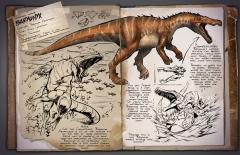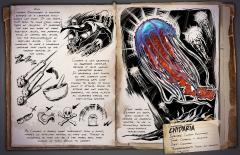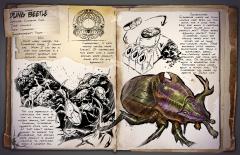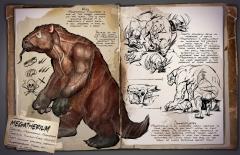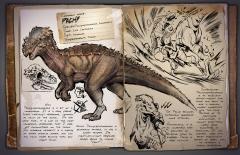Search the Community
Showing results for tags 'passive'.
-
hello i think the alberto should be added into the game because the sea feels really empty in ark SO why not add something huge to it like the alberto ok before you search up the size of it it was smaller than the mosa in length reaching lengths around 11-12 meters whilst the mosa reaches around 13-18 meters BUT wild card makes almost everything bigger than real life, The rhynio is a perfect example of this. So we could easily see the alberto way bigger like my idea. Ok so my idea for the alberto is to be a lot longer than the mosa and tuso so im thinking like 2 mosas + 1 tuso sort of length yeah so really big. It would be rather fast for its size and be rather tanky. here is some images of the albertonectes Taming method. so to tame this creature you must feed go to it and through out one of the creatures listed. coelacanth, sabertoothsalmonan, juvi meg and juvi tuso and let the alberto kill and eat them similar to the car car but it wont attack you. You would get max effectiveness by feeding it juvi tusos and not letting it get hit by anything, you will have less effectiveness if you feed it a meg, coelacanth or salmon. here is the list of the best creatures to feed it, top of the list being the best bottom being worsed. there is a massive difference between using a salmon or coelacanth than meg or tuso, for an example lets say you decide to feed a max level alberto coelacanths you would have to feed it like 10 more than a salmon 40 times more than a meg and 50 times more than a tuso. if your going to use coelacanths it would take 60 FEEDS if you use , if you use salmon 50 feeds, meg 20 feeds and tuso 10 feeds. the alberto will have a feeding timer around 2 minutes so if you are going to use coelacanths you will be there for 2 HOURS AND get less effectiveness so I do not recommend using them. use tusos if you can for shortest time spent taming remember this is an end game tame so trying to tame this with salmon or coelacanth will take way longer to tame, give less effectiveness and will have an even faster food drain than a meg or tuso tamed one. This is to encourage people to use meglodons and tusos more and make the alberto feel more end game. you might ask WHY ADD THE COELACANTHS AND SALMON IN THE FIRST PLACE well that's because you might want to try challenge yourself and make yourself suffer i find people like that sort of content on YT somethimes so it would be a good challange for content creators. . juvi tuso . juvi meglodon . salmon . coelacanth abilities listed here. . bite . neck bash . whirl pool: the alberto starts spinning rapidly and creates a whirl pool that sucks nearby boats and creatures down towards the alberto dealing constant damage . passively generates oil . fast food drain . cant be grabbed by tusos Saddles: so for the saddles it will have a standard saddle and a platform saddle BUT it also has a torpedo saddle making it like a war sub. Can launch up to 3 torpedo's from both sides of the alberto they can be destroyed by turret's. Ok I hope you like this idea and sorry for any incorrect punctuation I have never been that good at it. it may sound rather OP with the whirl pool and torpedo saddle and I will change it a bit if I get in the comments alot.
- 2 replies
-
- tameable
- titan of the sea
-
(and 4 more)
Tagged with:
-

Diprotodon ( New Abilities, New Taming Method )
darkrob99 posted a suggestion in Creature submission archive
Name: Diprotodon (Two forward teeth). Phonetic: Di-proe-toe-don. Named By: Richard Owen - 1838. Classification: Chordata, Mammalia, Marsupialia, Diprotodontia, Vombatiformes, Diprotodontidae. Species: D. optatum (type). Diet: Herbivore. Size: Up to 3 meters long, 1.8 meters tall at the shoulder. Possibly slightly bigger. Known locations: Australia. Time period: Calabrian to mid/late Tarantian of the Pleistocene. Fossil representation: Remains of hundreds of individuals making this one of the best known megafauna animals from Australia. Footprints and hair impressions are also known. Description: Diprotodon this majestic creature boasts a one-of-a-kind ability that sets it apart from all other dinosaurs in the ARK world - it harnesses the power of nature itself. Abilities: • Floral Manipulation: The Diprotodon has the extraordinary ability to manipulate plant life. It can summon thick vegetation, dense jungles, and vibrant flowers to create temporary barriers or ambush prey. Additionally, it can speed up plant growth, using them as camouflage or even as a source of nourishment. • Healing Aura: When the Diprotodon roars, it emits a healing aura that rejuvenates nearby creatures, both herbivores and carnivores alike. This ability proves to be invaluable during intense battles or when tending to wounded members of your tribe. • Pollen Dispersal: The Diprotodon releases clouds of mesmerizing pollen that can have various effects on other creatures. Some may become calmer and easier to tame, while others may experience temporary confusion, making them easier to avoid or manipulate. • Natural Harmony: Being in the presence of an Diprotodon encourages harmonious behavior in other nearby dinosaurs. It reduces aggressive tendencies, making conflicts less likely to occur. Location: This creature roams in the most secluded and untouched corners of the ARK world. To find the Diprotodon, players must venture deep into hidden forests or venture into secret caves hidden beneath the surface. Taming: Taming an Diprotodon is a complex and challenging process. It requires players to learn the secrets of the natural world, discover hidden rituals, and prove themselves as guardians of nature. Once tamed, the Diprotodon becomes a loyal and powerful companion, providing unparalleled support to the tribe. The Diprotodon would be a wonderful addition to the ARK video game world, offering players a unique and magical experience in their dinosaur adventures- 1 reply
-
- healing effect
- herbivore
- (and 5 more)
-

resource ANOMALOCARIS: The Resource Dredger
Smolfrog posted a suggestion in Creature submission archive
ANOMALOCARIS ----------------------------------------------------- BEHAVIOR Anomalocaris is a passive creature that spends its time in shallow ocean waters ( think of the east archipelago or the lava islands ) most of its time is spent dredging through the sand using its podomeres (those tentacles by its mouth) which kicks up a rich sand cloud, various resources and its preferred prey: Trilobites. When it finds a trilobite the Anomalocaris grabs it, cracks open its shell, and slurps out its delicious meat inside, however the trilobite is the only creature that the Anomalocaris gives any cares about. TAMING Anomalocaris is a simple tame and it would prove useful in early game and in late game, as stated before, the taming process is simple. A player simply needs to throw chitin and raw meat in the path of the Anomalocaris while its dredging for food, this works because Anomalocaris isn't the smartest of creatures and it believing that the player has given it a trilobite to eat. MOBILITY For what it is, Anomalocaris is pretty speedy in the water it can beat an itchy in a race but mantas are quite a bit faster, to reach these speeds Anomalocaris extends its podomeres to use them as hydrofoils. OXYGEN SUPPLY Similar to Diplocaulus, Anomalocaris has a supply of oxygen that gets trapped under its flipper plates and in its podomeres that can be accessed and used by players who are riding it, this oxygen supply is replenished any time the Anomalocaris exits the water BEACHING Anomalocaris is able to beach itself on the land for storage and to replenish its oxygen reserves, it does not dry out on the land and it is able to move however it is very slow and cannot attack while on the land. DREDGING as mentioned above Anomalocaris is an earlygame and a lategame tame, Dredging is where its lategame utility comes in to paly. When set to wander Anomalocaris will bury its podomeres into the ground and start moving around throught the sediments, the items that Anomalocaris pulls out of the ground is determined by the elevation that it is dredging at which is spilt into 4 different regions. Surface near the surface of the ocean such as a beach Anomalocaris is able to find resources that are useful for earlygame, the list of items is: Chitin, Stone, Thatch, Raw Fish, and Metal. Deep Water this area is found near the middle of the ocean, not at the sea floor but still a ways from the surface, here Anomalocaris will dredge up items useful for midgame the list of resources is: Cementing Paste, Raw Fish, Metal, Silicate (that one resource from extinction) and Obsidian. Abyssal The Center's oceans are very deep and here is where Anomalocaris is able to get many untapped resources, and the list of those is: Silicate, Obsidian, Black Pearls, Raw Prime Fish, Raw Fish, Metal, and rare element dust. Mountain There are quite a few small lakes found in the higher parts of the map, but the main spot to dredge would be the big lake of the center island, dredging here will give you: Organic Polymer, Cementing Paste, Raw Meat, Raw Prime Meat, and Metal. WHY? Anomalocaris marks an important point in the evolution of life as it was the largest creature for its time and its widely seen as the first apex predator, its also been a creature I've wanted to see in game for a long time. BASING IN REALITY A recent study has shown that Anomalocaris wasnt able to crunch down on trilobites too easily, instead its podomeres were used as hydrofoils for bursts of speed and agility. thank you for reading -
Species: Chaoyangsaurus🦎 Time: Late Jurassic🌤️ Diet: Herbivore🌿 Temperament: Passive defender🕶️ 💚Wild🦎 Chaoyangsaurus in the wild is a lively, social creature often traveling together with other passive creatures. They are friendly enough to come right up to you and look you over before venturing off to explore its surroundings. Enjoying warmer temperatures and lower climates with lush fauna or shrubs. Being no stranger to the aquatic life you can also find them in the swamplands. The Chaoyangsaurus is also fiercely loyal, and while it won't outwardly attack you, it will always rush to the defense of the passive creatures around it that are under attack, so be careful when hunting where these quick loyal defenders roam with other creatures. 💚Domesticate🦎 Chaoyangsaurus is a very curious and friendly creature that loves visual stimulation If you can lead one to your home it will often times settle right in with you. While not large enough to ride, the Domesticated Chaoyangsaurus makes for an excellent companion retaining their fierce loyalty and helping you in your day to day activities. Once a harness is crafted for them they are more than happy to hold your food and narcotics for you, and will even help you feed your tames in surrounding area! 💚Behavior🦎 The Chaoyangsaurus is a passive, friendly animal that is full of curiosity, often running up to new creatures that come into its path. Though they will never strike first once they or a fellow creature is in danger they will rush to the defense of others. 💚Passive Tame🦎 Chaoyangsaurus enjoys visual stimulation above all. Feed it it's favorite treat of a rare flower and it will follow you for a time. Leading it through your base, or other structures you have built will slowly tame it, the more advanced your build is, the faster it will tame, and the more different things for it to examine will raise it's efficiency. 💚Combat🦎 The Chaoyangsaurus is far from a fighter, but better than nothing. They will attempt a sweeping tale attack to knock back smaller creatures. While this attack is indeed weak it will not effect taming effectiveness of an unconscious creature. 💚Utility🦎 The Chaoyangsaurus is a early to mid game companion creature. Larger than your shoulder friends, but smaller than a raptor these fast creatures strive to be your best friend! If you fall unconscious they will try to wake you with gentle nudges. Once you build the harness for the Chaoyangsaurus They have a high carrying capacity for Berries🍇, meats🥩 and narcotics🐍. They can also be strapped onto other tames that have saddles, although they will need your help to detach from them. They will work as feeding troughs for your tames, automatically feeding them the most beneficial food and narcotics to nearby unconscious creatures, but will have no effect on passive tames. The harness can also be used as a mobile mortar and pestle. 💚Extras🦎 Chaoyang is not only a curious and intelligent creature but an obedient one, able to learn commands such as sit, or laydown, or play dead.🦎
- 16 replies
-
- submission
- support
-
(and 8 more)
Tagged with:
-
My suggestion is the Ctenophora, it looks like a jellyfish, but it does not belong to the cnidarea family, with fossils dating from the Cambrian period, it would be a shoulder creature, it would cling to the survivor from the back with tentacles, it would be transparent and with bioluminescence. While clinging to the survivor, she would have an ability to camouflage herself and the survivor, making both invisible, she would be found swimming in the liquid element, to be able to tame it would require a tek armor to enter the liquid element safely, the food it would be element ore, for balance issues, I imagine that invisibility could have a 10 second cooldown after becoming visible before being able to use it again, and that when attacking it would become visible again, invisibility time would depend on stamina. It would be a passive taming, we would have to give it elemental ore, it could only mate inside the liquid element, after being tamed, it would not die out of water, but it would be unable to move, just lying on the ground waiting for someone to come to take. In the dark of night or in caves it would glow with its bioluminescence, although it doesn't give enough light to illuminate anything, it would be nice to see it glow, with luminous tentacles wrapped around the survivor's torso and arms. Another ability it could have is when in water, it strives to supply its survivor with oxygen, spending its stamina, only recovering it as soon as it leaves the survivor's back or when the survivor leaves the water, thus, the stamina it is a very necessary status, and therefore it should be used well.
-
- invisibility
- oxigen
-
(and 6 more)
Tagged with:
-

Hear me out; Cerberus, the multi-headed beast
Jonm575 posted a suggestion in Creature submission archive
I know it’s a far cry from the guidelines, calling for real-world/prehistoric creatures.. but then again, there’s been a few fantasy creatures already. The basilisk takes up Jorgunmund, the snake. Tusotuethis takes up the kraken. Fenrir is fenrir. Ragnarök is an event Norse mythology; and Cerberus is a creature from Greek mythology. I’d hope that‘s enough to see where I’m coming from to pitch the idea, and I’ll refine it more with enough community approval/support A three-headed mashup between serpent and canine, which you would have to use a grappling hook to find your way upon it’s back, knockout one head, and passive tame another, while the central head is focused and aggro on you. Special abilities come to mind; heal nearby tribemembers per consumed Dino (instead of per meat from inventory) Drain target area stam/torpor (spit/venom) locate player spawn points (comes from the idea that it’s a dog, can sniff out to a certain distance, plus the fact that Cerberus was known in it’s mythology to keep the dead from returning to life; I hate PvP but even still, awesome concept.) I’d envision about the size of a paracertherium, perhaps a bit larger. Also, would sound more like an overgrown horse than a dancing giant with 2left feet. Seats up to 3 with a collar style saddle, or can support up to a paracer plat-sized saddle. Again, I realize I’m a bit outside of the guidelines for real world creatures, but we’re discussing Ragnarök…. I’m otherwise confined to valkyries and mermaids for ideas.- 1 reply
-
- fantasy creature .
- mythology
-
(and 2 more)
Tagged with:
-
From the album: Dossiers
Common Name: Achatina Species: Achatina Limusegnis Time: Holocene Diet: Herbivore Temperament: Passive Wild: Found mostly in marshes and jungles, Achatina Lumusegnis is a very slow, very non-threatening land mollusk. It might be the safest creature on the island to hunt, and while it only provides a small amount of meat and Chitin, An easy meal is always good on the island. Unlike nearly every other creature on the island, Achatina does not defecate normally. Instead, it secretes a thick, sticky substance. Achatina leaves trails of this slime, but the trails are so thin that they crumble to dust quickly. Domesticated: There is a very diguesting, but useful, fact about achatina that causes tribes to seek to tame them: its secretions are chemically similar to the 'cementing paste' used by many tribes for building materials. Tamed Achatina naturally build up this slime over time, which can then be collected at the tribe’s convenience.- 2 comments
-
From the album: Dossiers
Common Name: Ammonite Species: Ammonitina Multiamicus Time: Late Jurassic - Mid Cretaceous Diet: Bottom Feeder Temperament: Passive Wild: Usually found in the deepest parts of the waters around the island, Ammonitina Multiamicus has a strange relationship with the other creatures of the deep. It must do something beneficial for them, since every nearby sea creature defends Ammonitina when it is attacked. What this distinct symbiosis is based on, alas, I have not yet discovered. Ammonitina has also made its way into the deeper parts of underwater caves. Even within these caves, the creature will draw attention if assaulted, making harvesting its resource-rich shell a tricky proposition depending on what other dangers may be lurking nearby. Domesticated: Like many of the untamable ocean dwellers, Ammonitina still has enough utility to be a valuable hunting target. If a tribe is willing to risk the wrath of nearby would-be protectors, Ammonitina bile can be harvested from it’s corpse’s innards. This bile can be worked over with other chemicals to make many powerful concoctions, usually antidotes against the most powerful poisons and illnesses. Its shell meanwhile, is rich in rare materials, presumably due to the creature’s unique place along the Island’s food chain.-
- ammonite
- late jurassic
- (and 6 more)
-
From the album: Dossiers
Common Name: Baryonyx Species: Baryonyx Aquafulgur Time: Early Cretatceous Diet: Piscivore Temperament: Passive to land creatures, but aggressive to water-dwellers Wild: Like the Carnotaurus, Baryonyx Aquafulgur is one of the smaller end of the tier of large predators. While not as powerful as some deep sea predators or Spinosaurus, Baryonyx is an extremely fast swimmer who is still nimble enough to threaten most creatures on the island. And yet despite being a fast, dangerous dinosaur, Baryonyx almost exclusively eats fish & other water-dwellers. The highly specific metabolism of Baryonyx seems to allow it to heal wounds almost preternaturally fast after feeding on nutritious fish meat. Perhaps this is why Baryonyx rarely attacks land animals? Domesticated: Baryonyx's natural affinity for aquatic predation means that once tamed, it learns to kill ocean-dwellers more efficiently. Between its speed and its power, Baryonyx makes an ideal choice for anyone interested in frequently moving between water and land travel with ease, and valuing speend and agility over raw strength. -
From the album: Dossiers
Common Name: Cnidaria Species: Cnidaria omnimorph Time: Cambrian - Holocene Diet: Carnivore Temperament: Passive, but aggressive at close range Wild: Cnidaria omnimorph is another example of a creature which should not exist. It has traits that seem to come from many types of jellyfish. It possesses the size and shape of large egg-yolk jellies, the powerful sting of certain box jellies, and the bioluminescence of deep-sea jellies. This all combines to make a dangerous creature that lights up the deepest reaches of the ocean. Cnidaria is not generally an aggressive creature, because it lacks normal perceptive senses. it generally just floats on the current until something gets close enough to sense, at which point it attacks. While its attacks are not directly powerful, its sting injects an incredibly strong and fast-acting sedative. Most tribes kill Cnidaria on sight, then collect its reserve of powerful sedative, to use in technically advanced long-distance tranquilizers. Domesticated: As Cnidaria is barely more intelligent than a plant, there's no effective method to tame one. though dangerous as they can be, a few tribes even keep schools of them around to harvest.-
- cnidaria
- not tameable
- (and 8 more)
-
From the album: Dossiers
Common Name: Dung Beetle Species: Scarabidae Gigas Time: Holocene Diet: Coprophagic Temperament: Passive Wild: What magic created the Scarabidae Gigas, I cannot say. What I can say is that this creature is a perfect symbiont for advanced human tribes. Coprophagic, it eats mostly useless waste (feces). It metabolizes this waste into a more refined waste product, along with an oily byproduct. The oily byproduct is chemically the same as the oil found in the oceans around the island. Somehow, Scarabidae converts feces into oil. If that wasn't reason enough to worship the Scarabidae, the refined waste product is almost identical to fertilizer from a compost bin. Domesticated: Scarabidae makes me think humans have been on the island for a long time. Why else would a creature evolve to be such a perfect pet? Most tribes jealously protect their scarabidae, whom are handily tamed with the skilled use of some well-handled feces. These wondrous little organic biofactories are truly a sustainable, green, eco-friendly source of resources for living off the land. Oil becomes gas, which is generator fuel. Fertilizer means crops, which is human fuel. The scarabidae can power all aspects of island life!-
- dung beetle
- bug
-
(and 8 more)
Tagged with:
-
From the album: Dossiers
Common Name: Megatherium Species: Megatherium Formipavor Time: Late Pleocene-Early Holocene Diet: Omnivore, but primarily Herbivore Temperament: Passive, but aggressive to insects Wild: Megatherium Formipavor is one of the larger mammals on the island. This is most shocking because it is essentially a giant sloth... if you crossbred it with an elephant and a bear! Because of its size and girth, the Megatherium is uncommonly resistant to being knocked unconscious. Despite primarily being an herbivore, a typical Megatherium is very intent on consuming the island's many insects. It is particularly adept at removing their insides without damaging the shell, maximizing extraction of chitin. The otherwise slow and peaceful Megatherium becomes faster and more aggressive in the presence of these creatures. Domesticated: Megatherium is an incredibly useful creature to tame, so long as you don't intend to fight other tribes. Its enormity, high resistance to torpor, and voracious attitude toward insects (and arachnids) makes it ideal for farming large quantities of chitin from the bugs of the island, or simply defending against them!-
- megatherium
- mammal
- (and 10 more)
-
From the album: Dossiers
Common Name: Pachy Species: Pachycephalosaurus leniproelia Time: Late Cretaceous Diet: Herbivore Temperament: Passive Wild: Pachycephalosaurus is a bit of a conundrum. It is a very passive (even friendly) herbivore, common to much of the island. At the same time, it is one of the most dangerous herbivores that I have yet encountered on the island. Its charging headbutt is a display of sheer physical power, and can kill much more quickly than you might think. While Pachycephalosaurus is generally amiable, it has a short temper. Its fight-or-flight response always seems to choose "fight"! The Pachy becomes extremely aggressive once attacked. Additionally, it is an incredibly fast sprinter, so escaping from an enraged Pachy is very difficult. Domesticated: Pachycephalosaurus is an excellent battle-mount for those who want to ride a smaller, nimble combatant into the fray. Because of its particular musculature, it cannot effectively carry large quantities of resources. It can, however, move with brief magnificent bursts of speed, and its headbutt is simply devastating.-
- pachycephalosaurus
- rideable
- (and 7 more)




